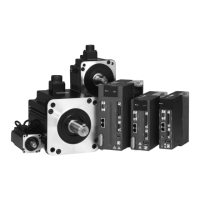Introduction of E-Cam Operation ASDA Series Application Note
2-10 March, 2015
Pulse
(Master)
PUU, Position
(Slave)
The pulse number
set in P5-89 for
disengaging.
P5-88.U = 4
P5-92 for
Lead
pulse
The pulse number
set in P5-89 for
disengaging.
Figure 2.14 P5-88.U = 4 Operation of E-Cam
In Figure 2.14, the lead pulse number specified by P5-92 is the one before the cycle starts; this
lead pulse is effective only when P5-88.U = 4 and E-Cam starts to work in a cyclic manner. No
matter what engaged/disengaged condition it is, as long as E-Cam is going to engage again after
disengaging, the lead pulse is still determined by P5-87. After E-Cam starts to operate in a cyclic
manner, the lead pulse is determined by P5-92.
Pulse
Master
)
Position
(Slave)
Reaches the lead pulse amount
Engaged
(
)
Engaging
Condition
fulfilled
P5-87
PUU,
Figure 2.15 Initial Lead Pulse Amount
In addition to settings mentioned above, there are other settings available. For example, setting
P5-88.U to 8 will disable E-Cam after disengaging, which is identical to the setting of P5-88.X = 0.
Disengaging E-Cam is different from disabling E-Cam. When E-Cam is disabled, this function is
completely unusable. On the other hand, while E-Cam is disengaged, E-Cam system remains
working although motor is stopped. Meanwhile, the slave axis is still monitoring the pulses sent
from the master axis. Disabling E-Cam is like switching off a car engine (P5-88.X= 0).
Disengaging E-Cam is like the car is in neutral and the engine remains on (P5-88.X =1).
Therefore, the function of P5-88.X is similar to the key for starting a car. Function of P5-88.UZ
can be regarded as the gear for controlling a car, which determines whether to engage or
disengage E-Cam. The setting of P5-88.U = 8 cannot be used individually; it has to set with the
disengaging timing, which can be set by Bit-OR for multiple selection. Except P5-88.U = 2, 4, and
6 that cannot be set simultaneously, disengaging timing can also be set by Bit-OR for multiple
disengaging timing. See table below.

